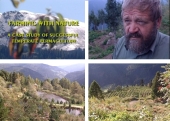







A centuries-old concept in soil science has recently been thrown out. Yet it remains a key ingredient in everything from climate models to advanced carbon-capture projects.
...
The Death of Humus
...
by the mid-20th century, the humus paradigm was “the only game in town,” ... Farmers were instructed to adopt practices that were supposed to build humus. Indeed, the existence of humus is probably one of the few soil science facts that many non-scientists could recite.
...
our understanding of the nature and genesis of soil humus has advanced greatly since the turn of the century, requiring that some long-accepted concepts be revised or abandoned.
...
powerful new microscopes and techniques such as nuclear magnetic resonance and X-ray spectroscopy allowed soil scientists for the first time to peer directly into soil and see what was there
...
What they found — or, more specifically, what they didn’t find — was shocking: there were few or no long “recalcitrant” carbon molecules — the kind that don’t break down. Almost everything seemed to be small and, in principle, digestible
...
the available evidence does not support the formation of large-molecular-size and persistent ‘humic substances’ in soils
...
Old ideas, however, can be very recalcitrant. Few outside the field of soil science have heard of humus’s demise.


Jordan Holland wrote:About a decade ago, we had a terrible ice storm in January. ... All of a sudden people realized that their half-million dollar house with fancy central air had no way of keeping them warm without electricity.

Tyler Ludens wrote:Personally I would like to see someone actually MAKE a functioning Vertical Farm, instead of just talking about them for decades.

The vertical farms that have been commercially active for several years all focus on the same crops. These are agricultural products with a high water content, such as lettuce, tomatoes, cucumbers, peppers, and herbs. However, these are not crops that can feed a city. They contain hardly any carbohydrates, proteins, or fats. To feed a city, it takes grains, legumes, root crops, and oil crops.
in Brussels - The Farm - explores what it would take to grow wheat in a vertical farm.
The experiment shows that growing 1m² of wheat in an artificial environment costs 2,577 kilowatt-hours of electricity and 394 liters of water per year.
The “farm” produces four harvests per year. With every harvest, enough wheat is grown to make one loaf of bread (580 grams), which has a cost of at least 345 euros. Each loaf contains 2,000 kilocalories, the amount that an average person needs per day. As a result, 91m² of artificially produced wheat is necessary for each person, with a total cost of 125,680 euros per year.

Nicole Alderman wrote:For those that back the kickstarter within the first two days--even at the $1 level--they get a whole host of free goodies (here's the list of all the goodies: https://permies.com/w/earlybird). And, one of the goodies is the first video in this documentary series.
